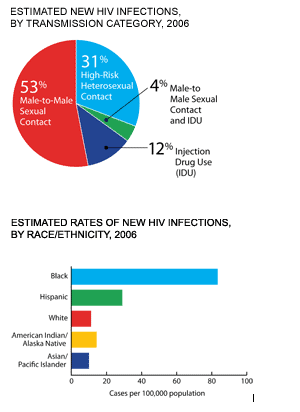| |
HIV Incidence, New HIV Infections: CDC Announcement
|
| |
| |
New technology and methodology developed by CDC show that the incidence of HIV in the United States is higher than was previously known. However, the incidence has been stable at that higher level for most of this decade. HIV incidence is the number of new HIV infections occurring during a certain time period, in this case, the year 2006.
These findings, published by in a special HIV/AIDS issue of the Journal of the American Medical Association (JAMA) that was released August 3, 2008, show that in 2006, an estimated 56,300 new HIV infections occurred - a number that is substantially higher than the previous estimate of 40,000 annual new infections. It should be noted that the new incidence estimate does not represent an actual increase in the numbers of HIV infections. Rather, a separate CDC historical trend analysis published as part of this study suggests that the annual number of new infections was never as low as 40,000 and that it has been roughly stable since the late 1990s (with estimates ranging between 55,000 and 58,500 during the three most recent time periods analyzed).

The new estimates show that gay and bisexual men of all races and ethnicities and African American men and women are the groups most affected by HIV. Fifty three percent of all new infections in 2006 occurred in gay and bisexual men. African Americans, while comprising 13% of the US population, accounted for 45% of the new HIV infections in 2006.
The analysis revealed some encouraging signs of progress as well significant challenges. Findings documented reductions in new infections among both injecting drug users and heterosexuals over time. Yet, the findings also indicate that HIV incidence has been steadily increasing among gay and bisexual men since the early 1990s, confirming a trend suggested by prior data showing increases in risk behavior, sexually transmitted diseases, and HIV diagnoses in this population throughout the past decade. The analysis also found that new infections among blacks are at a higher level than any other racial or ethnic group, though they have been roughly stable, with some fluctuations, since the early 1990s. The new estimates highlight the need for expanded HIV prevention services and should serve as a wake-up call that the US HIV/AIDS epidemic is far from over.
|
|
| |
| |
|
|
|